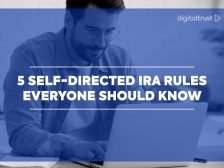After deciding on their favorite retirement vehicle, whether a 401(k), traditional or Roth IRA or Self-Directed IRA, the next step for smart investors could be to consider how to allocate those funds.
There are several topics to consider when deciding the best avenue for a retirement portfolio asset breakdown including but not limited to:
- Age
- Desired allocation percentages
- Risk tolerance
- Alternative assets
- Retirement goals
Armed with this information, investors can develop their top asset allocation strategy and then research the best avenues for their retirement accounts.
Traditional Asset Allocation
Traditional retirement portfolios, like an IRA or 401(k), often allocate assets based on a percentage of stocks and bonds. That type of mix has been considered safe to take investors through a variety of market risks.
Pros
The old proverb of retirement portfolio breakdown of 60/40 stocks and bonds worked because it was successful. The theory holds that stocks create growth potential while bonds provide stability.
Investors who favor security and are a little risk-averse might prefer to consider traditional allocation as a safety net because of its historical success.
Cons
The drawback to the old way of investing is that we’re not living in an old-world economy. Higher stock prices and fluctuations in interest rates have adjusted the new-world look at the “traditional” method.
Savvy investors who prefer stocks and bonds may consider a different percentage of asset allocation — like 85/15 — and hedge their bets using mutual funds instead of stocks and bonds.
Alternative Asset Allocation
Investors can hold many more options in a retirement account other than stocks, bonds, and mutual funds. Alternative assets include apartment buildings, homes, cryptocurrency, gold and more.
Nerd Wallet reports that nearly 60% of Americans are contemplating alternative asset investments, ranking real estate, commodities and crypto as some of their top considerations. A Self-Directed IRA gives investors the power to put their money to work through alternative investments.
Pros
Alternative investments allow smart investors to try to avoid the wild swings of the stock market. While stocks and bonds can change wildly, the value of peer-to-peer lending, for instance, isn’t typically based on market adjustments.
Just as with other investment options, alternative investments can be funded through pre-tax monies, and they may avoid the volatility of traditional public investing.
Cons
The cons to alternative investing depend on the investment selection. Some investment options have higher entry rates than traditional investments, while others create concerns about illiquidity because they are private investments.
Investors can try to hedge against some of these concerns by utilizing alternative investments as a smaller allocation investment. To avoid the traditional 60/40 asset allocation, what’s right for a riskier investment might look more like 15-20% in alternative investments.
Finding Other Investments
With a Digital Trust Self-Directed IRA, investors have the power to find alternative investments for their retirement. This technology-driven, self-directed approach to developing a driven retirement portfolio breakdown can help bring peace of mind to investors.
Recent market adjustments might have a lot of investors questioning: “What can they do today?” Alternating investment strategies to include alternative investments, like gold, crypto or real estate, provides an answer. An account with Digital Trusthttps://digitaltrust.com/ allows investors to control their retirement all in one place.



